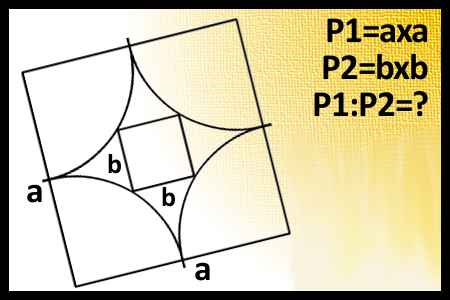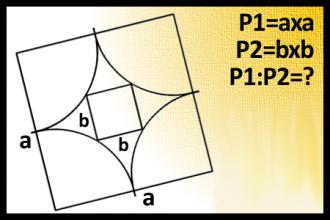Find the ratio of the areas of two squares
Find the ratio of the areas of two squares. Express result to the accuracy of 3 decimal.Correct answers: 38
The first user who solved this task is Djordje Timotijevic.
#brainteasers #math

A plane leaves Los Angeles air...
A plane leaves Los Angeles airport under the control of a Jewish captain. His copilot is Chinese. It's the first time they've flown together, and an awkward silence between the two seems to indicate a mutual dislike.
Once they reach cruising altitude, the Jewish captain activates the auto-pilot, leans back in his seat, and mutters, "I don't like Chinese."
"No like Chinese?" asks the copilot, "Why?"
"You people bombed Pearl Harbor, that's why!"
"No, no," the co-pilot protests, "Chinese not bomb Peahl Hahbah! That Japanese, not Chinese."
"Japanese, Chinese, Vietnamese... doesn't matter, you're all alike!"
There's a few minutes of silence...
"I no like Jews either!" the copilot suddenly announces.
"Oh yeah, why not?" asks the captain.
"Jews sink Titanic."
"What? That's insane! Jews didn't sink the Titanic!" exclaims the captain, "It was an iceberg!"
"Iceberg, Goldberg, Greenberg, Rosenberg ...no mattah... all same."
Once they reach cruising altitude, the Jewish captain activates the auto-pilot, leans back in his seat, and mutters, "I don't like Chinese."
"No like Chinese?" asks the copilot, "Why?"
"You people bombed Pearl Harbor, that's why!"
"No, no," the co-pilot protests, "Chinese not bomb Peahl Hahbah! That Japanese, not Chinese."
"Japanese, Chinese, Vietnamese... doesn't matter, you're all alike!"
There's a few minutes of silence...
"I no like Jews either!" the copilot suddenly announces.
"Oh yeah, why not?" asks the captain.
"Jews sink Titanic."
"What? That's insane! Jews didn't sink the Titanic!" exclaims the captain, "It was an iceberg!"
"Iceberg, Goldberg, Greenberg, Rosenberg ...no mattah... all same."

